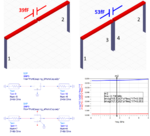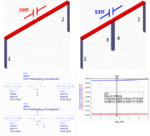cmosbjt
Full Member level 5

- Joined
- Apr 25, 2004
- Messages
- 250
- Helped
- 10
- Reputation
- 20
- Reaction score
- 2
- Trophy points
- 1,298
- Location
- USA
- Activity points
- 2,293
Hi All,
In HFSS, I am using Lumped Ports. I found that the capacitive coupling between ports are big.
I attached an HFSS project file here. I am simulating the capacitance between two metal traces.
In the first setup, I have only 2 ports at each end of traces. In the second setup, I added two more
ports that are very close to each other. After HFSS EM sim, I extract the snp and put them in ADS
to extract the parasitic capacitor from 2 port Y parameters. The first case gives 39fF and the second
case gives 53fF. The difference is rather big, 36% !
My question is, how to avoid/remove/calibrate out the port to port coupling? In a lot of cases, we need to
use many ports in the EM setup, and those ports have coupling to each other, then the EM becomes
less accurate as more ports are used.
Please help. Thanks a lot.

In HFSS, I am using Lumped Ports. I found that the capacitive coupling between ports are big.
I attached an HFSS project file here. I am simulating the capacitance between two metal traces.
In the first setup, I have only 2 ports at each end of traces. In the second setup, I added two more
ports that are very close to each other. After HFSS EM sim, I extract the snp and put them in ADS
to extract the parasitic capacitor from 2 port Y parameters. The first case gives 39fF and the second
case gives 53fF. The difference is rather big, 36% !
My question is, how to avoid/remove/calibrate out the port to port coupling? In a lot of cases, we need to
use many ports in the EM setup, and those ports have coupling to each other, then the EM becomes
less accurate as more ports are used.
Please help. Thanks a lot.


